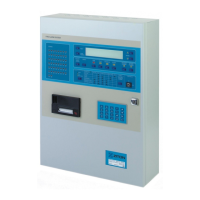24 ZP3 Fire Panel User Guide
For example, remove smoke from the detectors or replace the glass in a call
point. When you press Reset, the system restores to its normal state.
Fault alarms
A fault alarm displays on the panel as described in Table 9 below. The actions
carried out upon receipt of a fault alarm depend upon the procedures at the site
where the system is installed. The following are generic guidelines only.
Table 9: Fault alarms — annunciation and alarm
Remarks
LED Illuminated.
Zone screen showing details of the
zone or category with the fault, and
a general description of the fault.
buzzer Sounding continuously.
sounders Not sounding. Fault alarms are treated as a general alarm.
functions Active, if configured to operate (e.g. advising a
calling maintenance staff, etc.).
indicators Illuminated to indicate the affected system element. In addition, the
LEDs indicate which functions have been activated, such as advising
the remote manned centre, etc.
functions Delayed LED illuminated for those functions that are programmed to
operate in response to the fault alarm, and are configured for delayed
operation. These could be remote centre alarms or control functions.
Types of fault
The panel continuously monitors both itself and all external wiring and devices for
abnormal conditions. Faults can be categorized as shown in Table 10 below.
Table 10: Fault alarms — types of fault
Description
faults A system fault that takes the entire system out of operation, such as a
processor failure. This requires immediate action.
aults A fault that takes a small part of the system out of operation. This needs to
be repaired within the same day. Examples of limited faults are; a damaged
cable, or a mains failure where the batteries operate the system for the rest
of the day.
Operator action
1. Press the Accept button to acknowledge the alarm.
This silences the panel buzzer, and causes the flashing alarm indicators to go
steady.
Do not press the Reset or Silence Alarms buttons.
2. Call maintenance personnel to fix the fault.

